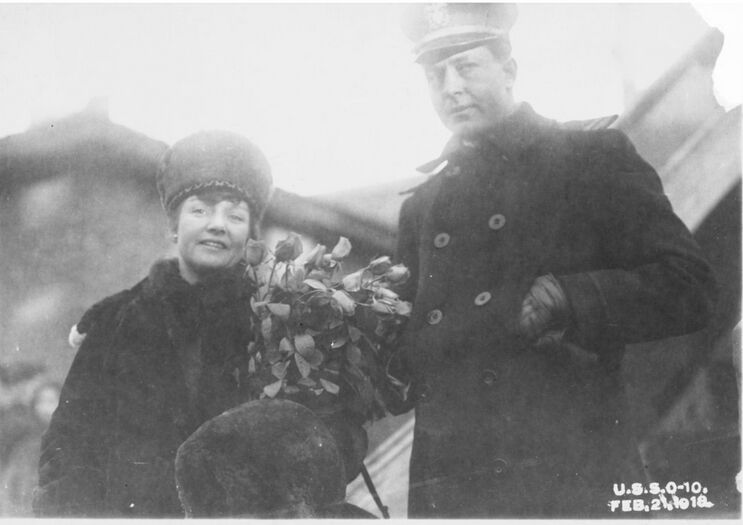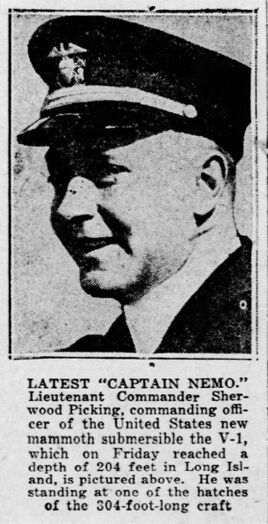SHERWOOD PICKING, CAPT, USN
Sherwood Picking '11
Lucky Bag
From the 1911 Lucky Bag:
Sherwood Picking
Baltimore, Maryland
OUR Admiral; the most ostentatiously "sea-going" member of the Class. Sherwood can tell you, more or less correctly, the tonnage, armament, and speed of every warship in the Seven Seas, and the characteristics of every yacht on the Atlantic sea-board. He is the inventor of an original war-game, by means of which he proved beyond a doubt that Cervera should have beaten Sampson "to a frazzle." Unfortunately for the War College, the narrow-minded ridicule of the Fifth Company caused this masterpiece to be laid away in a premature grave. His single-handed rescue of the stranded Argo and his material assistance that time on Youngster Cruise, when the Olympia's steamer fell from the davits, will long be famous. He is possessed of real capability, when he troubles himself to exert it. This coupled with an original point of view makes him a formidable opponent in argument, and a thinker whose ideas are as novel as they are practical.
Sherwood Picking was born in Baltimore, Md., on the 21st of February, 1890. He went abroad in 1899 and remained in Europe four years, attending "Real-schule," Cassel, Germany, and "LaVilla" Lausanne, Switzerland. On his return to the United States he attended Cheltenham Military Academy, and graduated. His present home is in Baltimore. He was appointed by President Roosevelt.

Sherwood Picking
Baltimore, Maryland
OUR Admiral; the most ostentatiously "sea-going" member of the Class. Sherwood can tell you, more or less correctly, the tonnage, armament, and speed of every warship in the Seven Seas, and the characteristics of every yacht on the Atlantic sea-board. He is the inventor of an original war-game, by means of which he proved beyond a doubt that Cervera should have beaten Sampson "to a frazzle." Unfortunately for the War College, the narrow-minded ridicule of the Fifth Company caused this masterpiece to be laid away in a premature grave. His single-handed rescue of the stranded Argo and his material assistance that time on Youngster Cruise, when the Olympia's steamer fell from the davits, will long be famous. He is possessed of real capability, when he troubles himself to exert it. This coupled with an original point of view makes him a formidable opponent in argument, and a thinker whose ideas are as novel as they are practical.
Sherwood Picking was born in Baltimore, Md., on the 21st of February, 1890. He went abroad in 1899 and remained in Europe four years, attending "Real-schule," Cassel, Germany, and "LaVilla" Lausanne, Switzerland. On his return to the United States he attended Cheltenham Military Academy, and graduated. His present home is in Baltimore. He was appointed by President Roosevelt.
Loss
Sherwood was lost on September 1, 1941 when the British bomber he was aboard crashed enroute to London. He was to assume duties as a naval attaché.
Other Information
From USS Picking (DD 685) organization:
The Picking was named in memory of Captain Sherwood Picking, USN, who died in a plane crash in Scotland en route to London on 1 September 1941.
Captain Picking was born in Baltimore, Maryland on 21 February 1890. He graduated from the U.S Naval Academy in the class of 1911. As LT he was the first captain of the USS O-10 (SS-71) when she was commissioned on 17 August 1918. As LCDR, he was commanding officer of the submarine S-7 when she was commissioned on 1 July 1920. The USS Barracuda (SS-163) was commissioned on 1 October 1924 and LCDR Picking was her first CO. He was promoted to Captain on 1 July 1939. During WWI, he was cited for distinguished and heroic action as Commanding Officer of a submarine which operated in waters infested with enemy vessels and mines.
In June 1936, Captain Picking was stationed at Harvard University in connection with the Naval Reserve Officers' Training Corps Unit. Later he was placed in command of Submarine Squadron Three, with additional duty commanding the Submarine Base at Coco Solo9, Canal Zone. He returned to the Office of the Chief of Naval Operations in April 1941, after which he was assigned to temporary duty in London, England.
From researcher Kathy Franz:
Sherwood was educated in France and was appointed to the Naval Academy by President Roosevelt.
In 1920, he was commander of the German submarine, the U-111. He brought her to Portland from Germany for study by the U. S. government.
In December 1923, Sherwood gave an illustrated lecture on submarine work at the Odd Fellows hall in Portsmouth, New Hampshire. In November 1928, Sherwood gave a lecture at the Brooklyn Institute entitled “Submarines and Their Operation” illustrated by lantern views and motion pictures.
He married Elizabeth Warner on June 25, 1927, in the South Church of Portsmouth, New Hampshire. Their children were Henry, Frances (Mrs. Frank Helyar) and Elizabeth (Mrs. William Hamill.)
In October 1935, Sherwood had the delicate duty of calling on the Japanese consulate at Shanghai to apologize for the incident at Tsing-Tao. Two American sailors from the submarine tender Canopus, under Sherwood’s command, were reported to have insulted the Japanese flag by tearing it down and stamping it under foot during a festival. Luckily, the sailors were arrested before the mob got them. Sherwood expressed regrets and promised that any proven offender would be disciplined.
In April 1940, Sherwood and his family lived on the Coco Solo Naval Reservation, Panama.
From The San Francisco Examiner, December 15, 1922
The myth of Wake island, shunned by sailors for 10 years as the Lorelei of the Pacific ocean, and believed to be the center of a maelstrom that reached out to destroy unwary mariners, has been explored by the United State Navy, according to information received from Washington at Twelfth Naval District headquarters yesterday.
The report came from Lieutenant Commander Sherwood Picking of the USS Beaver, who formed a landing party ashore and found that Wake island is a Garden of Eden.
In place of the swirling maelstrom Lieutenant Picking found inside the rim of the island, which is coral, a placid lagoon on the shores of which are tropical groves of dense small trees, where thousands of birds were found, so tame that they could be picked up and fondled.
He also served on French submarines during WWI, according to this contemporary report of his loss. At some point he was stationed in the Philippines and China.
A diary he kept while observing English and French submarine operations in WWI is in the holdings of the Naval History and Heritage Command.
Sherwood was survived by his wife, son, and daughter. Sherwood is buried in Maine.
He is not listed as an overseas casualty of WWII.
Photographs
From Hall of Valor:
The President of the United States of America takes pleasure in presenting the Navy Cross to Lieutenant Commander Sherwood Picking, United States Navy, for distinguished service in the line of his profession as commander of the U.S.S. 0-10, making passage to the Azores and operating in European waters against enemy submarines during World War I.
Service: Navy
Division: U.S.S. O-10
Other
The Maine Historical Society has his handwritten recipe for the creation of gin—circa 1925, during prohibition. It also has a diary titled "Cruise of the schooner Salee, 30 August 1939 to 20 March 1940, Solomon Islands, Maryland--Rio de Janiero-- Miami, Florida : the diary of Captain Sherwood Picking, USN."
In March-April 1941 Sherwood was a part of an expedition investigating the possibility of establishing a biological station in the Galapagos Islands.
Picking family papers are in the collection of the Library of Congress:
Consists of the collected documents of Laura Sherwood Picking (1856-1933) and Henry Forry Picking (1840-1899), as well as the papers of their son Sherwood Picking (1890-1941) and his wife Elizabeth Warner Picking (1899-1999). Compiled and donated by Sherwood's son, Henry [Ricky] Forry Picking (1931-2013), the family papers chronicle the adult lives of Laura and Henry, center around Sherwood Picking's life until his tragic accident in 1941, and continue in part into the life of Ricky Picking himself. Contains correspondence, family documents, photographs, building receipts, books, blueprints, pamphlets, travel documents, passports, naval documents and paperwork, sketches, newspaper clippings, a stamp collection, Henry F. Picking's trunk, decorative frames, a pair of spectacles, scrapbooks, Bibles, pamphlets, World War I ration stamps, carved wood blocks, and legal documents. Also includes correspondence from World War II submarine commander, Admiral Charles A. Lockwood. The Picking family includes multiple generations of naval history, the vast majority collected and passed on by the women in the family. It includes the photographs of and the correspondence of Laura Sherwood Picking and Elizabeth Warner Picking (the donor's mother). These two women form the basis of the collection because they were the ones who kept the correspondence, images, and newspaper clippings from the war years during which their husbands and sons fought. The correspondence, books, and photographs give a glimpse into the life of this historic family and the tumultuous years in which they lived. The collection is split into the correspondence and documents of Laura Sherwood Picking's family and the correspondence and documents of Elizabeth Warner Picking's family. Both women collected the majority of the correspondence and by dividing thematically and chronologically by each woman, the collection maintains a sense of its original organization. For genealogy of the Warner family, see the source file. There is also a model of the schooner Gladiator made by Sherwood Picking (ca. 1925), located in the library reading room.
Sherwood authored the book "Sea Fight Off Monhegan: Enterprise and Boxer"; it was published in 1941, after his death.
The "Register of Commissioned and Warrant Officers of the United States Navy and Marine Corps" was published annually from 1815 through at least the 1970s; it provided rank, command or station, and occasionally billet until the beginning of World War II when command/station was no longer included. Scanned copies were reviewed and data entered from the mid-1840s through 1922, when more-frequent Navy Directories were available.
The Navy Directory was a publication that provided information on the command, billet, and rank of every active and retired naval officer. Single editions have been found online from January 1915 and March 1918, and then from three to six editions per year from 1923 through 1940; the final edition is from April 1941.
The entries in both series of documents are sometimes cryptic and confusing. They are often inconsistent, even within an edition, with the name of commands; this is especially true for aviation squadrons in the 1920s and early 1930s.
Alumni listed at the same command may or may not have had significant interactions; they could have shared a stateroom or workspace, stood many hours of watch together… or, especially at the larger commands, they might not have known each other at all. The information provides the opportunity to draw connections that are otherwise invisible, though, and gives a fuller view of the professional experiences of these alumni in Memorial Hall.
January 1912
January 1914
January 1915
January 1916
January 1917
March 1918
January 1919
January 1920
January 1921
January 1922
May 1923
July 1923
September 1923
November 1923
January 1924
March 1924
May 1924
July 1924
September 1924
November 1924
January 1925
March 1925
May 1925
July 1925
October 1925
January 1926
October 1926
January 1927
April 1927
October 1927
January 1928
April 1928
July 1928
October 1928
January 1929
April 1929
July 1929
October 1929
January 1930
April 1930
October 1930
January 1931
April 1931
July 1931
October 1931
January 1932
April 1932
October 1932
January 1933
April 1933
July 1933
October 1933
April 1934
July 1934
October 1934
January 1935
April 1935
October 1935
January 1936
April 1936
July 1936
January 1937
April 1937
September 1937
January 1938
July 1938
January 1939
October 1939
June 1940
November 1940
April 1941
Namesake
USS Picking (DD 685) was named for Sherwood; the ship was sponsored by his widow.
Memorial Hall Error
Sherwood is not included in Memorial Hall, though his loss is clearly operational. His situation almost exactly mirrors that of George Grove '15, who was lost only a few months before on a British bomber in Iraq while on his way to assume duties as a naval attaché.

The "category" links below lead to lists of related Honorees; use them to explore further the service and sacrifice of alumni in Memorial Hall.



